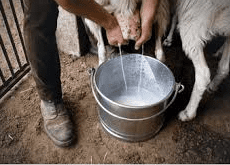The quality of female sheep milk is directly related to the nutrition and mineral fed before and after the ewe gives birth to the lamb. The shearing or feeding of high-quality stored forages and supplement correct balance of fats and carbohydrates changes or results in better milk production for the ewe.
Fats tend to have very high energy more than carbohydrates, and lambs normally digest fat more effectively and efficiently to grow and perform better at an early age.
Ways to increase Sheep Milk for Maximum Profit

The following are how you can increase your sheep milk production and improve lamb performance;
1. Supplement sheep for better milk production
You can add nutritional supplements such as vitamins, herbal extracts, or chemical components.
This is done to meet dietary deficiencies and enhance muscular development to encourage better milk production.
According to research, providing a supplementary fat ahead i.e before lambing, directly correlates or results to improve milk quality which also supports lamb performance.
Therefore, supplementation has proven to be needed to maintain proper milk production.
Most ewes naturally graze on dormant grasses or hay before lambing in the late winter or spring, therefore supplementation is necessary to maximize and increase milk quality especially if the ewes gaze forage is low in both fat and protein.
Read Also: How to Make a Baby Goat Kid Lick a Block
2. Factor in multiple births
Usually, ewes that carry multiple lambs have extra nutrient requirements to support milk fat production.
Research has shown that a pregnancy ultrasound can provide some insight into the ewes belly whether the ewe has higher nutrient needs or not.

If two or more two lambs defect, you should consider moving the ewe into a group of other ewes expecting multiple ewes as well.
Warmly the multiple lamb flock can receive more supplemental fat and very high-quality forage to make the ewes adequately care for their lambs post lambing.
This process also benefits the ewe since she can maintain her body condition easier with additional nutrients.
Make sure you monitor your lambs very well to know or see if they have full bellies.
If they look as if they have a space in the flank and are not adding weight, it can be a sign of malnutrition or nutritional problems may be one of the twins will need to be pulled off early or it could be that the ewe will need more supplemental fat to provide the adequate milk production levels and also to support the growth of the lamb.

3. Don’t always cut corners with sheep mineral
A good quality mineral is the most important thing to feed your ewe or sheep with.
Once the sheep mineral is being given to them or fed at the specified rates and quantity, it helps to keep everything in ewes and lambs.
According to research, sheep minerals must have at least a degree of bio-availability to ensure the minerals are properly absorbed and used by the ewes.
Also, a very high amount of this bioavailability in your mineral product allows not only for better absorption by the ewe but for lamb as the most needed mineral and vitamins are passed through the milk to the lamb.
You should get a mineral that is high in organic zinc, manganese, and also cobalt.
These minerals help to impact ewes metabolism and also affect the amount and quality of milk that is produced.
They help to provide very high bioavailability to support the overall milk production.
The purine wind and rain sheep mineral help to offer the right and the best balance of vitamins and bioavailable minerals to keep ewes and their lamb performing very well at their optimum.
Read Also: E-Waste: Complete Guide to Properly Dispose your Electronic Wastes
4. Pull back at weaning for ewe
According to research, a healthy and well-fed lamb can gain up to 1 / 3 ib per day while on milk.
As lambs tend to reach a higher weight, let’s say at six weeks of age, they can change into a creep feed and start grazing.
At this point, their rumen has started to develop and can fully utilize or make use of nutrients from a forage-based diet.
You can therefore start by introducing the creep feed at an early age of five weeks as it takes roughly five to seven days before a lamb can start getting used to or develop a full interest in creep feed following its introduction.
It is very good and important that the creep feed is high in protein such as Purina lamb starter which mostly contains 16 percent of crude protein.
According to experts in the field, when ewes are supplements for too long, it can result in issues like mastitis therefore adequate care must be taken in order not to make this mistake.
Ideally, lambs are weaned at least 8 weeks old, and providing a high-quality sheep nutrient program before, during, and after lambing helps to ensure your ewe will produce high quality and high-fat milk to support the optimal growth of the lamb and performance.
In conclusion, raising milk sheep and sheep milk production requires more attention.
In the nutrition area, legume, grass, pasture, and forages with a very high percentage of legume will always result in increased milk production.
Grazing of ewes can also be of good importance to additional supplementation with increased milk yield.
However, it is very good and important to match the supplement to the quality of the grazing.
This is where I will be ending our today’s discussion on better ways to increase your sheep milk to maximize your profits.
Read Also: Causes of Regular Abortion on Pregnant Goats and Control Measures
